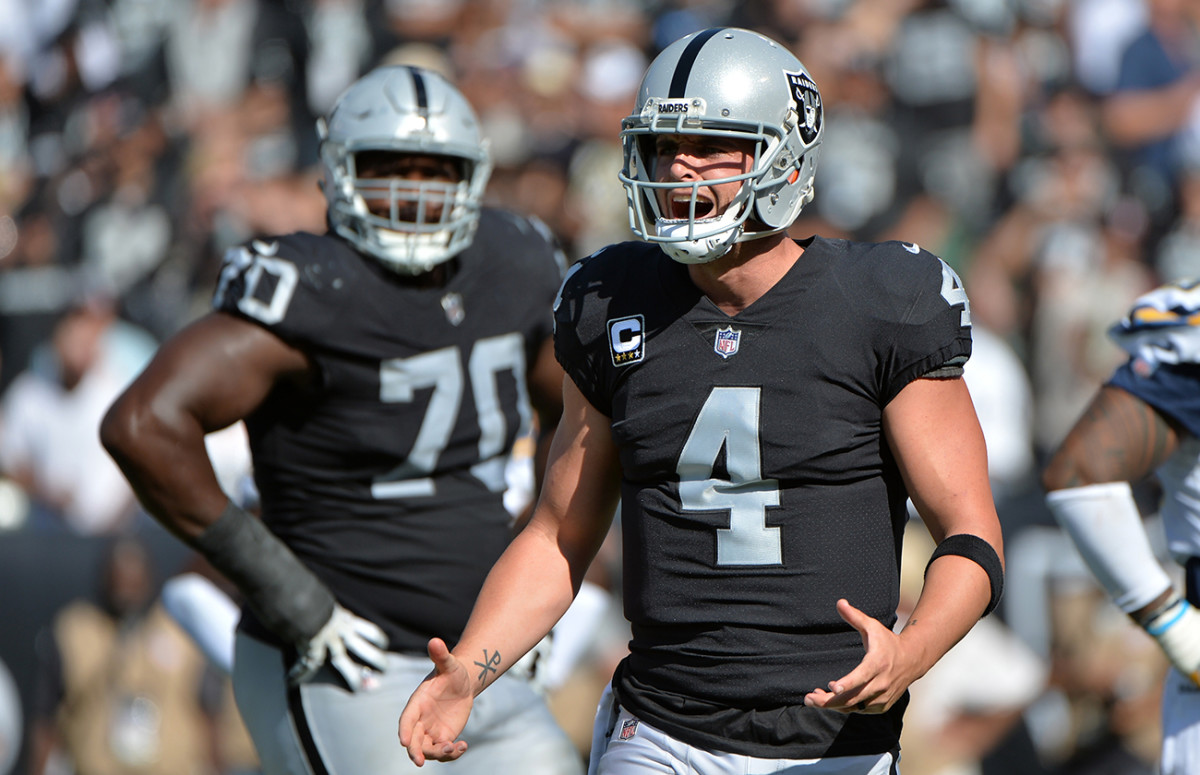What Oakland’s Offense Is Missing

In recent years, many teams have found themselves in a close contest with the Chargers. But not many have ended up on the wrong end of it. The Raiders did on Sunday—at home, no less. After twice defeating the Chargers by three last season, they fell 17-16 on a buzzer-beating 32-yard Nick Novak field goal, which capped a 10-play, 78-yard Chargers drive that took the last four minutes and nine seconds off the clock.
That drive offered a microcosm of Oakland’s defensive problems. Running back Melvin Gordon, who slowly bled the Raiders all game with nine catches for 67 yards, ran six times for a chain-moving, clock-killing 25 yards. It was yet another referendum on an Oakland linebacking corps that’s just barely better than those your local high school would face. (2016 sixth-rounder Cory James has been the steadiest force of that unit, and he’d be barely a third starter on running downs for many teams.)
Early in that final drive, Philip Rivers completed passes of 34 and 23 yards to tight end Hunter Henry on designer route combinations that stressed Oakland’s safeties and underneath defenders. Those were Rivers’ two biggest downfield throws, which is something of a small miracle: Oakland’s other problem has been giving up deep shots. Cornerback Sean Smith, who all but specializes here, was benched for this game. (T.J. Carrie and Dexter McDonald played well in Smith’s stead.) Safety Reggie Nelson, still a viable edge blitzer, no longer has the twitch and speed to patrol centerfield. (His long-term replacement, Obi Melifonwu, was drafted in Round 2 but landed on I.R. in September with a knee injury.)
Consequently, the Raiders have had to play a lot of zone, often with two safeties deep. Their vaunted four-man pass rush is supposed to compensate, but it remains perplexingly inconsistent. So, that’s what is wrong with the 2-4 Raiders. Except, these were concerns last season, as well, when the Raiders’ fourth loss came January 1. This year, something is up with the offense.

Maybe Derek Carr, who returned from the low-back fracture suffered in Week 4, is not 100%. But even before his injury, this offense was hiccupping. Almost every team has at least one disastrous outing a year. Oakland’s came in front of everyone on a Sunday night at Washington in Week 3; it seems like this offense still hasn’t recovered. During this current four-game skid, the Raiders are averaging 13.3 points.
The offense’s two distinct characteristics remain the same as last year: a quick-strike spread passing game and an inside power running game. But in and of themselves, those yield 3-6 yards a snap. It’s about the explosive plays you can build off of them. Previous offensive coordinator Bill Musgrave was tremendous here. Musgrave leveraged the power running game into first- and second-down aerial deep shots (often with extra men pass-blocking). He also used presnap motion and formational wrinkles to texturize the quick passing game and create matchup problems.
We’ve seen some of this from new offensive coordinator Todd Downing, but only bits. The six-year quarterbacks coach (three years with Detroit, one with Buffalo and two with Oakland) was promoted to Musgrave’s post because of his rapport with Carr. Downing would expand some of Oakland’s situational packages and eradicate some of the concepts that Carr didn’t like. You’d get a more comfortable QB, which means a more dynamic offense. Big plays, presumably, would follow.
Two Replacements for Aaron Rodgers, Deshaun Watson Breaking Records, Is Adrian Peterson Back?
But they haven’t. We saw few explosive designer plays against the Chargers on Sunday. That’s notable. As a predictable Cover 3 defense, the Chargers have faced tailormade vertical-shot plays all season. Teams know how to get their receivers matched deep against L.A.’s linebackers. The Chargers had also faced unbalanced formations with overloaded route combinations, flooding specific areas of their zones. To their credit, they’ve improved against all of this, but these are still the concepts that challenge their scheme. They’ll see them every week.
Or, almost every week. By failing to really challenge L.A.’s Cover 3 zone scheme, not only did the Raiders short themselves, they also didn’t help their own struggling weapons. Wideout Amari Cooper has not been getting open on the outside. He needs to be moved around and aided by the play designs; if he’s not beating corners, put him against linebackers. Jared Cook, who was the answer to Downing’s offseason wishes for a dangerous receiving tight end, has 21 receptions for 209 yards. He’s not being deployed diversely, the way he was in Green Bay.
This is not to rip Downing. His job, like any coach’s, is contingent on many factors, including ones we can’t see and some he can’t control. Marshawn Lynch and the offensive line, for example, have not provided the ground game that Oakland had under Musgrave. And Carr’s injury, even if it did come after the offensive woes began, cannot be summarily dismissed. Any offense will take a step back if its franchise quarterback is compromised.
That said, when waters get rough, an offensive coordinator must build rafts. The Raiders’ offense is young and talented, on the field and the sideline. Downing must open up his scheme.
Film-charting specialist Allan Uy contributed to this article.
• Question or comment? Email us at talkback@themmqb.com.
